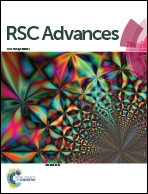Elemental anion thermal injection synthesis of nanocrystalline marcasite iron dichalcogenide FeSe2 and FeTe2†
Abstract
We report a hot-injection colloidal method for the synthesis of nanocrystalline (NC) iron diselenide (FeSe2), and iron ditelluride (FeTe2) derived from iron(II) bromide as the iron (Fe) precursor. These highly crystalline iron chalcogenides are synthesized by injecting elemental selenium (Se) or tellurium (Te), complexed with oleylamine, into a reaction flask containing the iron precursor. NC FeSe2 and FeTe2 films have been characterized by using X-ray diffraction (XRD), scanning electron microscopy (SEM), and Raman spectroscopy. Both FeSe2 and FeTe2 NC particles exhibit marcasite phase with orthorhombic crystal structure. The as-synthesized NC FeSe2 and FeTe2 show irregular shapes with consistent stoichiometric ratio. In addition, we discuss these iron chalcogenides with regard to their thin film electronic properties including sheet resistance, resistivity, majority carrier type, and their possible device applications.


 Please wait while we load your content...
Please wait while we load your content...